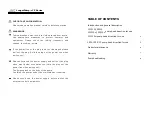
DNR-1 Noise Reducer Instructions
The DNR-1 is a single channel digital background noise reduction processor. It is designed to connect directly to any SM1
series microphone (or any line level input signal) and a DRV, I/P camera, etc. Note- the audio output of the DNR-1 is “line
level” (0db).
SM1 Microphone Placement
Locate the SM1s microphones as close as possible to the areas of interest in the space to be monitored. Do not mount
the microphones near air conditioning vents, light fixtures or electrical equipment. The SM1s should be placed at least 5
feet away from the subject(s) to be monitored. An SM1 is still useable in the range of 15-25 feet but is dependent on the
level of background noise in the area. Experimentation in the environment will determine what distances work best.
DNR-1 location and power
The DNR-1
interface box is designed to be located next to a DVR or I/P camera. The DNR-1
(unless connected to an ETS
interface box or base station) requires a 120VAC power source within 3 feet of its location. If this is not possible in your
application, you can splice in up to 100 feet of 18 awg, 2 conductor cable to extend the distance between the AC power
source and the DNR-1.
Cable Run
Run a 22 gauge, stranded, two conductor shielded cable between the DNR-1
module and the SM1 microphone. Keep the
cable run distance under 1,000 feet and away from AC power sources, light fixtures and electrical equipment.
See Figure
1 for connection diagram.
Audio inputs
Connect any SM1 series microphone OR any other “line level” type signal. Do not use both inputs at the same time.
Noise Reduction Switch
This switch is provided so that the user can compare unprocessed audio to processed audio. You can demonstrate how
effective the DNR-1 is at removing unwanted background noise. Note-when the noise reduction is on, the high frequency
response of the input audio is reduced to below10Khz. This is not typically an issue if conversations are the subject of
observation.
DNR-1 audio output
This output is typically connected to the audio input of the DVR, I/P camera, etc. You can extend this output up to 1000
feet using audio coaxial cable and 2 field installable RCA (or 3.5mm) connectors.
DNR-1 connection to an ETS interface or ETS base station
Run up to 500 feet of 2 conductor shielded cable between the DNR-1 and an ETS interface or base station. Connect 12v
to 12v, audio to audio and tie the shield ends com (-) to com (-). Note- when connected to an ETS base station or
interface, the AC adaptor that comes with the DNR-1 is not required.
Setting Input / Output levels
Use the input level control to cut or boost the audio input level. If the level is too high and distortion is noticed, turn the
level control towards the “-“ position (CCW). If the signal is not loud enough, turn the control towards the “+” position
(CW). The amount of post processor gain can be set with the output level control. Up to x11 gain is possible. Start with
lower levels and experiment with this control until you get the desired audio level and minimal distortion.
Please
note- there is a minimum input signal volume level of noise required by the DNR-1 before the noise cancelling will take
effect. Only by experimentation (with the microphone’s gain control and the DNR-1’s input level control) and listening to
the result in the application, will confirm when the noise cancelling is working properly. There will be a very noticeable
reduction in the amount background noise present when the DNR-1 is operating correctly.




















